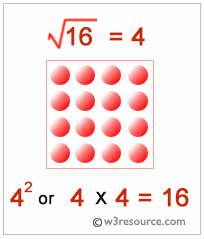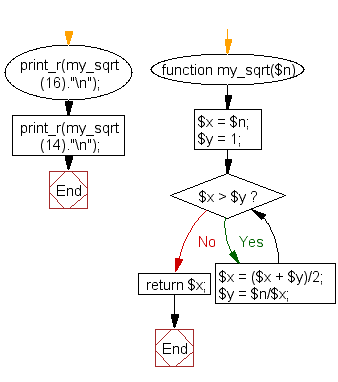PHP Challenges: Compute and return the square root of a given number
PHP Challenges - 1: Exercise-8 with Solution
Write a PHP program to compute and return the square root of a given number.
Input : 16
Explanation :

Sample Solution :
PHP Code :
<?php
function my_sqrt($n)
{
$x = $n;
$y = 1;
while($x > $y)
{
$x = ($x + $y)/2;
$y = $n/$x;
}
return $x;
}
print_r(my_sqrt(16)."\n");
print_r(my_sqrt(14)."\n");
?>
Sample Output:
4 3.7416573867739
Flowchart:

PHP Code Editor:
Contribute your code and comments through Disqus.
Previous: Write a PHP program to find three numbers from an array such that the sum of three consecutive numbers equal to a given number.
Next: Write a PHP program to find a single number in an array that doesn't occur twice.
What is the difficulty level of this exercise?
Test your Programming skills with w3resource's quiz.
PHP: Tips of the Day
How to Sort Multi-dimensional Array by Value?
Try a usort, If you are still on PHP 5.2 or earlier, you'll have to define a sorting function first:
Example:
function sortByOrder($a, $b) {
return $a['order'] - $b['order'];
}
usort($myArray, 'sortByOrder');
Starting in PHP 5.3, you can use an anonymous function:
usort($myArray, function($a, $b) {
return $a['order'] - $b['order'];
});
And finally with PHP 7 you can use the spaceship operator:
usort($myArray, function($a, $b) {
return $a['order'] <=> $b['order'];
});
To extend this to multi-dimensional sorting, reference the second/third sorting elements if the first is zero - best explained below. You can also use this for sorting on sub-elements.
usort($myArray, function($a, $b) {
$retval = $a['order'] <=> $b['order'];
if ($retval == 0) {
$retval = $a['suborder'] <=> $b['suborder'];
if ($retval == 0) {
$retval = $a['details']['subsuborder'] <=> $b['details']['subsuborder'];
}
}
return $retval;
});
If you need to retain key associations, use uasort() - see comparison of array sorting functions in the manual
Ref : https://bit.ly/3i77vCC
- New Content published on w3resource:
- HTML-CSS Practical: Exercises, Practice, Solution
- Java Regular Expression: Exercises, Practice, Solution
- Scala Programming Exercises, Practice, Solution
- Python Itertools exercises
- Python Numpy exercises
- Python GeoPy Package exercises
- Python Pandas exercises
- Python nltk exercises
- Python BeautifulSoup exercises
- Form Template
- Composer - PHP Package Manager
- PHPUnit - PHP Testing
- Laravel - PHP Framework
- Angular - JavaScript Framework
- Vue - JavaScript Framework
- Jest - JavaScript Testing Framework
